03.11.2023 | Published by iGEM
.png)
As part of our partnership with iGEM, the biggest synthetic biology competition in the world, we are showcasing some of the exciting projects from teams that share our vision of synbio impacting positively on human health. In this last post, we've let the team from Nazarbayev University, Kazakhstan take over our blog to share what they are working on. They are presenting a project called CellCare, a therapeutic vaccine against solid carcinoma tumors.
Setting up our team
We have 20 members on our team, mostly undergraduate students from Nazarbayev University from different majors and years of study. Since we have a lot of people in the team, we divided it into two major subteams: implementation and human practices and communication team, we also chose heads for these departments. Below, you can learn more about them.
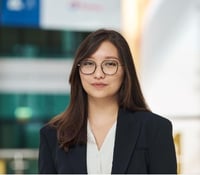
Anel Umirbaeva (team leader) - 4th year Undergraduate Biological Sciences student. Anel is a leader of the whole team and works on the project conceptualization, work and team organization, development of project trajectory, and many more. She is also responsible for meeting all the deadlines in iGEM cycle and keeping up a positive working environment in the team. “I love biology, I really do. I have always been curious about its practical applications and biofoundry, in particular. I think iGEM is the right place for a person like me who is eager to find his path in the synbio industry or cutting-edge research.”
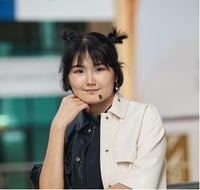
Adina Kadyrova (implementation team head) - 4th year Undergraduate Biological Sciences student. Being the head of the implementation team which includes all wet lab and dry lab activities, Adina mainly worked on the experimental design, lab resource management, safety maintenance, and training of the wet lab members. Adina is also a person who was responsible for plasmid design and parts registration. “Thanks to iGEM and its endless valuable resources, I managed to learn more about synbio and its specificities. I think that it will definitely impact my career and further research interests in a very positive way.”
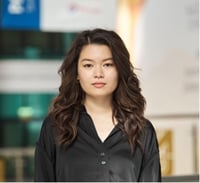
Ainur Aimurziyeva (human practices and communication team head) - 3rd-year Undergraduate Biological Sciences student. Ainur greatly contributed to the organization of all our public engagement activities, showing a great commitment and interest in holding the first-ever BioArt fashion show in Kazakhstan. She was also responsible for all the human practices and science communication while also maintaining a friendly atmosphere in the team. “I joined iGEM because I wanted to learn something new, obtain new skills, and expand my experience. I think I achieved my aims and hope that they will help shape my further career path. ”
Human health
We present our project called CellCare which is a therapeutic vaccine against solid carcinoma tumors. This vaccine is designed to deliver engineered non-pathogenic E.coli to the tumor site. Upon introduction of bacteria to the tumor microenvironment, they will be activated by a high lactate concentration and release the anti-cancer bacterial toxin Colicin E1 which produces pores on the surface of cancerous cells, leading them to apoptosis. However, we realize that there will be a harsh immune reaction towards bacteria. This led us to think more about the safety and efficiency of our product, and so we decided to deliver those bacteria via a crystalline hydrogel. The hydrogel’s part is to ensure the safe transfer of bacteria, release toxins through its porous structure, attach to the cancer cells (due to the hyaluronic acid present in the gel), provide specificity, and most importantly prevent immune response and severe inflammation. We designed a chitosan-based thermosensitive and biodegradable hydrogel which will be solidified upon local administration and will encapsulate bacteria from escape.
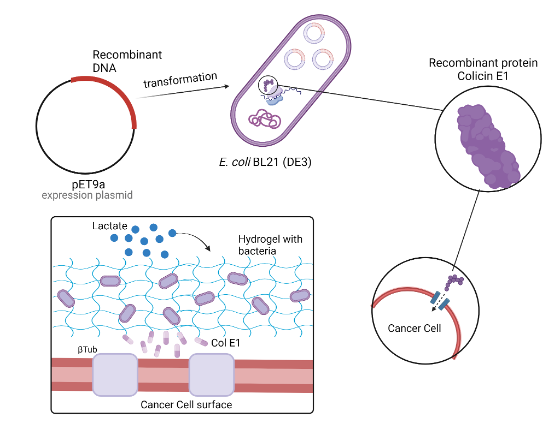
This vaccine will provide a sustainable, controlled, and specific drug release to carcinoma tumors like those in breast cancer, prostate cancer, colon cancer, lung cancer, skin cancer, and many more. What’s more is that bacterial presence in the human organism will still maintain immunomodulatory properties, recruiting immune system components to the tumor site. We hope that this drug can be used in combination with existing treatments or be a substitute for them, having no deleterious effects on humans, ensuring high specificity and efficacy, and boosting a patient's own immune system.
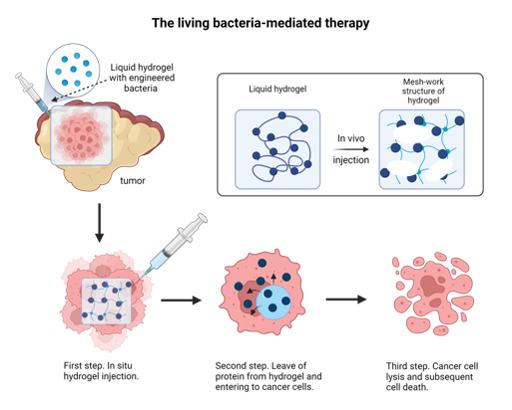
Synbio trends
We believe that youth possesses a huge power in terms of creativity, enthusiasm, and the ability to think out of the box, and it is important that we have an environment where we can show ourselves and build new things. iGEM is exactly such a place, offering us the potential to grow not only in the synbio field but also in other aspects, letting us expand our horizons, and supporting our initiatives and ideas. We chose to compete in iGEM mainly to learn more about synbio, biofoundry, scientific responsibility, bioart, and try ourselves in these fields. Also, obtaining hands-on experience while working in the lab, on the wiki, or meeting with prominent figures in the Biotech industry really helps us shape our understanding of what research looks like, how we can implement it, and what we should do to make an impact either locally or globally. Most importantly, we extremely enjoyed it and had a lot of fun while working as a team and being a part of the iGEM community.
Challenges
We believe that the biggest challenge that we faced this year was the reagents order and delivery to Kazakhstan. Here, we have a very complicated system of customer services and policies regarding reagent delivery, especially, if it is a plasmid or DNA sequence. Fortunately, with the assistance of our PIs, mentors, and biotech experts, we finalized the plasmid design and managed to order it. However, the plasmid arrived way later than expected, and we had to rush with our experiments a little bit.
Another major challenge was synthesizing a perfect hydrogel which will have pore sizes small enough to encapsulate bacteria and large enough to release toxin protein. We tried several options of gel with various compositions, and only after three months of hard work were we able to obtain what we needed.
Scientific resources
Our team is especially proud of the hydrogel that we designed, and we collected a meticulous description of its structure, optimized protocols, engineering cycles that we underwent to ensure the suitability of the gel, and also some proof of concept information on our wiki, which you can access using this link. We believe that hydrogels will change the world of drug delivery and medicine in general, for it has a plethora of unique and easy-to-adjust properties needed for disease treatment.
Moreover, we know that equity, inclusivity, and diversity in science are pillars of technological success and advances. With that in mind, we have focused on delivering high-quality educational content to visually impaired school children to learn more about STEM via our inclusive summer camps, BioArt exhibitions, various lectures, and many more. But we did not stop on that, our BioArt exhibition this year has leveled up to the BioArt fashion show that we conducted to show a larger audience the importance of cancer diagnostics and problems that we as scientists encounter finding a cure for. All of this information can be found on our wiki and Instagram page.